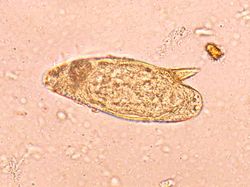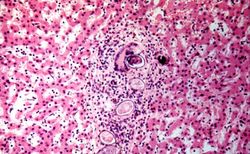Difference between revisions of "IPLab:Lab 11:Schistosomiasis"
Seung Park (talk | contribs) (Created page with "== Images == <gallery heights="250px" widths="250px"> File:IPLab11Schistosomiasis1.jpg|This is a high-power photomicrograph of the patient's fecal specimen containing the char...") |
Seung Park (talk | contribs) (→Images) |
||
| (7 intermediate revisions by the same user not shown) | |||
| Line 1: | Line 1: | ||
| + | == Clinical Summary == | ||
| + | This 30-year-old white male was admitted to the hospital following an upper gastrointestinal hemorrhage with repeated hematemesis. On admission he was tachycardic and had orthostatic hypotension. Endoscopy revealed the presence of esophageal varices. Following fluid replacement and control of bleeding, the patient appeared well. Careful physical exam revealed a palpable spleen extending to the umbilicus. Ascites was not present. The hematocrit was 27%, the white count 12,000 with 30% eosinophils, and the platelet count 98,000. The patient denied alcohol use and had no history of hepatitis. However it was found that two years prior to admission he had worked as a Peace Corps volunteer on a fish-farming project in Ghana. He had been generally healthy while in Africa. He could recall only a fever and cough lasting two or three days, and a brief episode of fever, chills, and headache which was empirically treated as malaria, although no parasites were seen on a single peripheral smear at the time. Since his return to the U.S. eighteen months ago, he had been in good health, but had occasionally noticed some vague left upper quadrant discomfort. Examination of the stool for ova and parasites revealed a few Schistosoma mansoni eggs. | ||
| + | |||
== Images == | == Images == | ||
<gallery heights="250px" widths="250px"> | <gallery heights="250px" widths="250px"> | ||
| Line 5: | Line 8: | ||
File:IPLab11Schistosomiasis3.jpg|This is a photomicrograph of the liver from another patient with Schistosoma mansoni. These eggs have elicited a robust inflammatory response, including a multinucleated giant cell. These lesions go on to heal by fibrosis resulting in cirrhosis and the classic "pipe-stem" fibrosis. | File:IPLab11Schistosomiasis3.jpg|This is a photomicrograph of the liver from another patient with Schistosoma mansoni. These eggs have elicited a robust inflammatory response, including a multinucleated giant cell. These lesions go on to heal by fibrosis resulting in cirrhosis and the classic "pipe-stem" fibrosis. | ||
</gallery> | </gallery> | ||
| + | |||
| + | == Study Questions == | ||
| + | * <spoiler text="How did the patient acquire schistosomiasis?">Fresh water snails are required intermediate hosts for schistosomal organisms. The snails release cercaria into the water that can penetrate the skin of anyone walking in the water. Since this patient worked on a fish farm, he spent a lot of time in the water.</spoiler> | ||
| + | * <spoiler text="How do Schistosoma mansoni eggs cause liver pathology?">A substance released from the eggs is a direct hepatotoxin. The eggs incite a chronic granulomatous inflammatory reaction (thought to be mediated by TNFa and T-helper cells). And schistosome eggs stimulate lymphocytes to secrete lymphokines that stimulate periportal fibrosis.</spoiler> | ||
| + | * <spoiler text="How does the clinical picture of S. haematobium differ from that of the other schistosomes?">S. haematobium leads to granulomatous lesions in the urinary bladder that can erode the surface epithelium and lead to hematuria. Chronic inflammation and fibrosis can lead to obstruction, hydronephrosis and ascending bacterial infections. There is also an increased risk for squamous cell carcinoma of the bladder.</spoiler> | ||
| + | |||
| + | == Additional Resources == | ||
| + | === Reference === | ||
| + | * [http://emedicine.medscape.com/article/228392-overview eMedicine Medical Library: Schistosomiasis] | ||
| + | * [http://emedicine.medscape.com/article/788867-overview eMedicine Medical Library: Emergent Management of Acute Schistosomiasis] | ||
| + | * [http://www.merckmanuals.com/professional/infectious_diseases/trematodes_flukes/schistosomiasis.html Merck Manual: Schistosomiasis] | ||
| + | |||
| + | === Images === | ||
| + | * [{{SERVER}}/library/index.php?/tags/2164-schistosoma PEIR Digital Library: Schistosomiasis Images] | ||
| + | * [http://library.med.utah.edu/WebPath/GIHTML/GIIDX.html WebPath: Gastrointestinal Pathology] | ||
| + | * [http://library.med.utah.edu/WebPath/LIVEHTML/LIVERIDX.html WebPath: Hepatic Pathology] | ||
| + | |||
| + | == Related IPLab Cases == | ||
| + | * [[IPLab:Lab 2:Fatty Change and Cirrhosis|Lab 2: Liver: Fatty Change and Cirrhosis]] | ||
{{IPLab 11}} | {{IPLab 11}} | ||
[[Category: IPLab:Lab 11]] | [[Category: IPLab:Lab 11]] | ||
Latest revision as of 01:46, 30 August 2013
Contents
Clinical Summary[edit]
This 30-year-old white male was admitted to the hospital following an upper gastrointestinal hemorrhage with repeated hematemesis. On admission he was tachycardic and had orthostatic hypotension. Endoscopy revealed the presence of esophageal varices. Following fluid replacement and control of bleeding, the patient appeared well. Careful physical exam revealed a palpable spleen extending to the umbilicus. Ascites was not present. The hematocrit was 27%, the white count 12,000 with 30% eosinophils, and the platelet count 98,000. The patient denied alcohol use and had no history of hepatitis. However it was found that two years prior to admission he had worked as a Peace Corps volunteer on a fish-farming project in Ghana. He had been generally healthy while in Africa. He could recall only a fever and cough lasting two or three days, and a brief episode of fever, chills, and headache which was empirically treated as malaria, although no parasites were seen on a single peripheral smear at the time. Since his return to the U.S. eighteen months ago, he had been in good health, but had occasionally noticed some vague left upper quadrant discomfort. Examination of the stool for ova and parasites revealed a few Schistosoma mansoni eggs.
Images[edit]
Study Questions[edit]
Additional Resources[edit]
Reference[edit]
- eMedicine Medical Library: Schistosomiasis
- eMedicine Medical Library: Emergent Management of Acute Schistosomiasis
- Merck Manual: Schistosomiasis
Images[edit]
- PEIR Digital Library: Schistosomiasis Images
- WebPath: Gastrointestinal Pathology
- WebPath: Hepatic Pathology
Related IPLab Cases[edit]
| |||||
Hematemesis is the vomiting of blood.
Cirrhosis is a liver disease characterized by necrosis, fibrosis, loss of normal liver architecture, and hyperplastic nodules.
Hematuria is the presence of blood in the urine.
Hydronephrosis is dilation of the renal pelvis and atrophy of the cortex due to increase pressure from retained urine.


